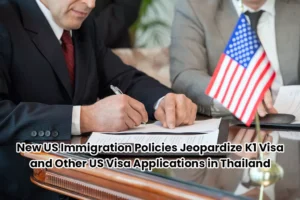In the realm of U.S. immigration, the path to reunification for couples can be complex, but crucial decisions need to be made. For many couples, the choice often boils down to the K1 visa and K3 visa. Both visas serve the purpose of bringing spouses of U.S. citizens to the United States, but they differ in their eligibility criteria, processing times, and overall suitability for different situations.
Understanding the Basics
K1 Visa: The Fiancé(e) Visa
The K1 visa, commonly known as the Fiancé(e) visa, is designed for engaged couples where one partner is a U.S. citizen. Its primary advantage lies in its quicker processing time compared to other family-sponsored visas. The K1 visa allows the foreign fiancé(e) to enter the U.S. to get married within 90 days.
K3 Visa: The Spouse Visa
On the other hand, the K3 visa, officially titled the Spouse visa, is intended for foreign spouses of U.S. citizens. The primary goal of the K3 visa is to expedite the immigration process for married couples. It allows the foreign spouse to enter the U.S. while the immigrant petition is pending.
Eligibility Criteria
K1 Visa Eligibility
To qualify for a K1 visa, the couple must demonstrate a bona fide intention to marry, with the U.S. citizen petitioner filing a petition on behalf of their foreign fiancé(e). The couple should have met in person within the two years preceding the filing of the petition unless meeting in person would violate cultural or religious customs or result in extreme hardship.
K3 Visa Eligibility
For the K3 visa, the U.S. citizen spouse must file both Form I-130 (Petition for Alien Relative) and Form I-129F (Petition for Alien Fiancé(e)). The marriage must be legally valid, and the foreign spouse must be the beneficiary of Form I-130. Unlike the K1 visa, there is no requirement for the couple to have met in person in the last two years.
Processing Time
K1 Visa Processing Time
The K1 visa is generally known for its quicker processing time compared to the K3 visa. On average, it takes about 6 to 9 months for the entire process, from petition filing to visa approval. However, processing times may vary based on the workload of the specific U.S. embassy or consulate.
K3 Visa Processing Time
The K3 visa, while designed to expedite the immigration process for married couples, may not always live up to its reputation. Processing times for the K3 visa can range from 8 to 12 months or more. The delays are often attributed to administrative processes and the need for additional documentation.
Travel Authorization and Employment
K1 Visa Advantages
Upon entering the U.S. on a K1 visa, the fiancé(e) is eligible to apply for work authorization through Form I-765. This allows them to work while waiting for the adjustment of status. Additionally, the K1 visa holder can travel outside the U.S. and return using an advance parole document while waiting for the green card.
K3 Visa Advantages
Similar to the K1 visa, the K3 visa holder can apply for work authorization through Form I-765. However, the K3 visa does not include automatic travel authorization. If the foreign spouse leaves the U.S. while the I-485 (Application to Register Permanent Residence or Adjust Status) is pending, they may encounter issues returning.
Adjusting Status and Green Card
K1 Visa Adjusting Status
After marrying the U.S. citizen sponsor, the K1 visa holder must apply for adjustment of status using Form I-485. This process is crucial for obtaining a green card and granting permanent residence to the foreign spouse.
K3 Visa Adjusting Status
Like the K1 visa, the K3 visa holder must file Form I-485 for adjustment of status. This process is essential for obtaining permanent residency and, eventually, U.S. citizenship.
Cost Considerations
K1 Visa Costs
While both visas incur processing fees, the K1 visa may involve additional expenses, such as medical examination fees and fees for obtaining supporting documents. It’s essential to budget for these extra costs when considering the K1 visa route.
K3 Visa Costs
The K3 visa process includes filing fees for both Form I-130 and Form I-129F. Similar to the K1 visa, there may be additional costs for medical examinations and supporting documents.
Potential Risks Associated with Each Visa Option
K1 Visa Risks
- Conditional Residency: After marriage, the K1 visa holder must apply for adjustment of status to obtain conditional residency. If the marriage is terminated within two years, the foreign spouse may face deportation.
- Strict Timelines: The 90-day window for marrying after entry on a K1 visa needs to be more flexible. Delays or unforeseen circumstances can lead to complications, including the need for a visa extension or reapplication.
- Ineligibility for K1 Visa: In cases where the couple cannot meet the in-person requirement or faces cultural or religious barriers, the K1 visa may not be a viable option.
K3 Visa Risks
- Extended Processing Times: Delays in processing times for the K3 visa can be a significant risk, potentially prolonging the separation of the couple.
- Travel Restrictions: Unlike the K1 visa, the K3 visa does not provide automatic travel authorization. Traveling outside the U.S. while the I-485 is pending may pose challenges in returning.
- Adjustment of Status Complications: Issues with the adjustment of the status process, such as incomplete documentation or legal complications, may lead to delays or denials.
Conclusion: Making the Decision
In choosing between the K1 and K3 visas, couples must weigh the factors that are most relevant to their unique situation. The K1 visa is ideal for engaged couples seeking quicker reunification, while the K3 visa offers a pathway for married couples to navigate the immigration process together.
Ultimately, the decision hinges on individual circumstances, priorities, and the urgency of reunification. Consulting with an immigration attorney can provide valuable insights tailored to the specific needs of the couple, ensuring a well-informed decision on the journey to building a life together in the United States.
Contact Siam Legal
 | Ken Graham US Immigration Attorney Partner, Siam Legal International |
 | Natdaphon Luengsawang Senior US Visa Consultant Siam Legal International |
LIVE SUPPORT
 CALLCall (702) 799 9719 |  CHATChat with our representative | |
| From US: Sunday – Friday 5:00 PM – 7:00 AM (New York time) 2:00 PM – 4:00 AM (Los Angeles time) From Thailand: Monday – Friday | ||







































